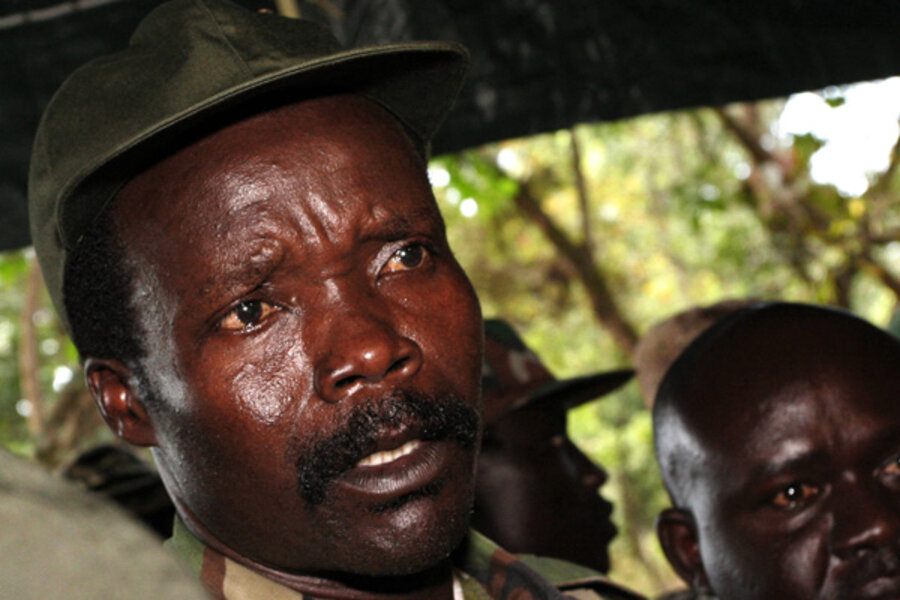Hunt for Kony becomes a casualty of Central African Republic overthrow
• A daily summary of global reports on security issues.
African troops in the Central African Republic suspended their long hunt for warlord Joseph Kony following a rebel overthrow of the president there last month, a top Ugandan military official said.
Some fear the move could serve as a dangerous lifeline allowing Mr. Kony and his Lord’s Resistance Army to regroup, and could wreck havoc on a country already facing a government taken by force.
Rebels in the Central African Republic (CAR) deposed the president there more than a week ago, and the country’s membership in the African Union has been suspended. The Associated Press reports that the AU mission has been put on hold until the troops’ mandate there is clarified, with African forces retreating to military bases within CAR.
"These rebels have been openly hostile to us and following that, the president [of Uganda, Yoweri Museveni] has ordered us only to be in defensive positions," Dick Olum, head of Ugandan troops in the force hunting Kony and also the overall force commander, told Reuters. "So we've temporarily suspended offensive operations against the LRA for now until we receive further orders."
Yesterday, the United States listed Kony as a wanted war criminal, and issued a bounty of more than $5 million for information leading to his capture. About 100 US advisers have been a part of the mission to find Kony in central Africa since 2011. [Read more about the US involvement here.]
According to The Wall Street Journal the decision to pull back 3,000 African Union troops, the majority of which are Ugandan, is a setback for the mission and puts CAR at heightened risk for violence.
More broadly, it feeds into gathering worries that the mineral-rich but poor country is at risk of becoming ungovernable and vulnerable to drug traffickers, criminal groups or terrorist organizations that could threaten security well beyond its borders—a fate similar to one that has befallen Somalia and Mali.
Kasper Agger agrees. He works for a US-based Enough Project, which has followed the violence wreaked by Kony and the LRA across central Africa. He told the AP that it would be a “catastrophe for civilians in the Central African Republic" if the African troops left the country.
"All the top commanders of the LRA are in the Central African Republic. That is where the center of gravity of the operations should be,” Mr. Agger said. “This will only give the LRA a new safe haven."
The LRA is believed to be about 250-men strong today, but they typically travel through the jungle in smaller groups – always moving – in order to remain inconspicuous.
Kony took up arms in Uganda the late 1980s, in what he said was an effort to protect the Acholi people in the north from President Yoweri Museveni’s troops in the south. Close to 2 million people were displaced and forced into camps at the height of the conflict, reports Agence France-Presse. In the mid-1990s Kony’s LRA splintered into neighboring countries, including Sudan and the Democratic Republic of Congo.
According to The Christian Science Monitor, the accusations against Kony and the damage he has caused to communities across central Africa are severe and widespread:
Accused of kidnapping at least 30,000 children as porters, soldiers, and sex slaves since he launched his insurgency on behalf of northern Uganda’s Acholi people against the mainly southern Ugandan Army of President Yoweri Museveni in 1988; accused of forcing children to murder their own parents in order to break ties to their home communities; accused of mass murder of perhaps 100,000 people and feeding his army through pillage; [by 2006] Kony had already been labeled a mass murderer by human rights groups and as a terrorist by the US government.
In 2005, Kony became the first person indicted by the International Criminal Court, facing 33 charges that include murder, rape, and kidnapping children, reports a separate Monitor story.
Last year an online video produced by the non-profit Invisible Children went viral, calling for the capture of Kony. The video had “phenomenal success,” in raising awareness about Kony and the LRA, and the Twitter hashtag #stopykony was widespread. But the project was simultaneously hailed for driving youth toward activism and criticized for oversimplifying the multitude of issues surrounding the LRA’s history in Africa, reports The Monitor.
On a US State Department blog yesterday, Secretary of State John Kerry said:
Kony and his cronies have eluded capture for years. The LRA is broken down into small bands of rebels, scattered throughout dense jungle, hidden by dense canopy, controlling territory through tactics of fear and intimidation. We know they will not be easy to find.
But we know that rewards have a proven track record of generating tips that help authorities find fugitives and hold them accountable -- just look at the example of criminals and butchers from conflicts in Sierra Leone, the former Yugoslavia, and Rwanda, all brought to justice in part through the use of rewards.
Mr. Kerry issued a similar bounty for a war criminal associated with the Rwandan genocide, and reminded readers that there are outstanding bounty offers on other suspected war criminals as well.







